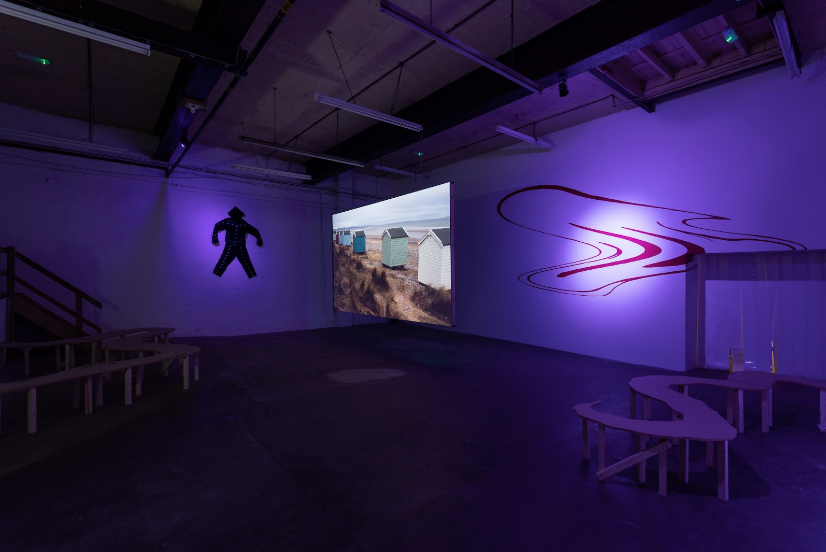Ten Years of Two Queens
2022 marks the ten-year anniversary for Two Queens in Leicester. Amrit Doll speaks to Daniel Sean Kelly and Gino Attwood about the highs and lows of running an artist-led gallery and studio space.

Benedict Drew, The Onesie Cycle, 2013
Courtesy Two Queens, Leicester
Courtesy Two Queens, Leicester
Established in 2012, Leicester’s artist-led gallery and studios, Two Queens, is known for their contemporary exhibitions by emerging artists. Having presented over 70 shows and accommodating 48 artists in their studios, Two Queens has become a household name in the Leicester art scene. This year, the organisation reaches its 10th birthday. Amrit Doll talks with founding members and co-directors, Daniel Sean Kelly and Gino Attwood, to discuss how the space was started, what they do differently to other organisations and what they have planned next.

Michaela Cullen, Cathedral of Worms, January 2022
Courtesy Two Queens, Leicester
Courtesy Two Queens, Leicester
Amrit Doll: Two Queens was created by two artist collectives from different universities. How did that happen, and how was the gallery and studio space founded?
Daniel Sean Kelly: In 2011, I was part of CUSP and Gino was part of Vanilla Galleries. We had both been running projects in Leicester with our respective collectives and wanted to continue with similar activities. The closing of Leicester’s contemporary gallery, The City Gallery, in 2010 highlighted the need for a new exhibition space and there were also very few affordable artist studios.
Gino Attwood: We were matchmade by a member of Leicester City Council, who suggested we take on a building together. CUSP was looking for artist studios and Vanilla Galleries were looking for exhibition space, so we agreed to work together.
Daniel Sean Kelly: Originally, CUSP and Vanilla Galleries would alternate exhibitions. By 2012, projects were run collaboratively and Gino and I became co-directors.

Hannah Quinlan and Rosie Hastings, Something for the Boys 2018
Courtesy Two Queens, Leicester
Courtesy Two Queens, Leicester
AD: Did you ever envisage that Two Queens would continue for ten years or was it seen as a temporary space?
GA: At first, we had a temporary lease so we did not expect to stay longer than six-months. Having a financial model based on the studios, helped develop organisational sustainability, which was always a central aim. We wanted Two Queens to be something that exists for people in the city and a space that we would want to have in our hometown.
AD: Two Queens previously exhibited artist group shows but now primarily works with one artist at a time. Why is that and how do artists get selected for the gallery programme?
GA: In 2013, we hosted a solo show, The Onesie Cycle (&VIP) by Benedict Drew. He was confident with his practice and led the exhibition process. We learned a lot from that experience and it inspired us to offer solo shows where artists are encouraged and empowered to take creative control in the same way.
DSK: We offer artists an almost-blank slate opportunity that is a rare thing for galleries to offer to artists. We approach artists with an invitation to exhibit when we think they are confident enough to explore their ideas and they are moving into the next stage of their career. To find suitable artists, we get to know them and their practices, visit shows, and check out social media platforms.
AD: What is your approach to curation?
DSK: The term ‘curator’ sets up a hierarchical system, whereas we prefer to work with artists as peers. We consider ourselves facilitators, creating an environment where the artist feels they can take risks with their practice, producing something unexpected and thereby getting a lot more out of the experience. An example of this is the film Something for the Boys by Hannah Quinlan and Rosie Hastings (2018). This was a more ambitious film work than any they had made previously and went on to be shown in Kiss My Genders at the Hayward Gallery (2019).

Vanilla Galleries, The News, 2012
Courtesy Two Queens, Leicester
Courtesy Two Queens, Leicester
AD: What have been the ups and downs in the development of Two Queens?
GA: We could have been more entrepreneurial in the early stages, however, we wanted to keep our studios affordable so kept prices low. The most rewarding part of the experience is being part of the Two Queens community, where we can share ideas and think about art together.
AD: How will you celebrate your ten-year birthday?
DSK: We will have a birthday party with everyone who has supported us over the years, and we will become community-owned to secure our future in our building. Also, by working with our two curatorial bursary holders we’ll be bringing in different approaches to curation. We are also devising new ways of working with artists that seek to place more control over the exhibition process into artist's hands.
AD: What advice would you give to anyone who wants to develop their own artist-led space?
GA: Get the lay of the land by asking lots of people for information. Talk to the landlord rather than the estate agent and get someone to re-assure the landlord that you can manage a space. Do not be afraid of things going wrong and create a sustainable business model that allows you to fund the kind of projects you want to do.
https://2queens.com
By Amrit Doll
25 March 2022

